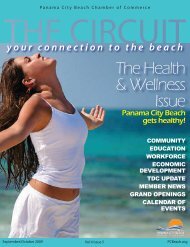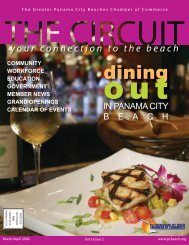View This Issue - Panama City Beach Chamber of Commerce
View This Issue - Panama City Beach Chamber of Commerce
View This Issue - Panama City Beach Chamber of Commerce
You also want an ePaper? Increase the reach of your titles
YUMPU automatically turns print PDFs into web optimized ePapers that Google loves.
Health & Wellness | Eating Healthy<br />
Health<br />
&<br />
Wellness<br />
Health<br />
Benefits<br />
<strong>of</strong> Sushi<br />
• If you are looking for<br />
a fast-food meal that is<br />
healthy – or you just enjoy<br />
the flavors and art form<br />
<strong>of</strong> sushi – you are sure to<br />
benefit from a visit to your<br />
local sushi bar. Popular for<br />
centuries in Japan, sushi<br />
has become immensely<br />
fashionable in the Western<br />
world. Although sushi’s<br />
history goes back to the 7th<br />
century, the trendy form that<br />
is served in modern sushi<br />
bars came into popularity in<br />
1820, Tokyo. Variations <strong>of</strong><br />
the lengthy pickling process<br />
that was the original variety<br />
<strong>of</strong> sushi were made so that<br />
sushi could be enjoyed<br />
freshly made from a portable<br />
stall.<br />
Sushi is a very healthy meal<br />
made mostly with rice,<br />
fish and vegetables. What<br />
are the health benefits <strong>of</strong><br />
sushi? High content <strong>of</strong> fish<br />
9<br />
oil is the main health factor<br />
which promotes a healthy<br />
cardiovascular system. The<br />
hikarimono, or shiny fish<br />
(mackerel, Spanish mackerel,<br />
sardine, Pacific Saury), contain<br />
the highest amounts <strong>of</strong><br />
EPA and DHA omega3 fats.<br />
Ironically they are the least<br />
expensive fish. These fish<br />
are also high in vitamin E<br />
which is a powerful antioxidant.<br />
Nori, the thin, toasted seaweed<br />
sheets used in rolled<br />
(maki) sushi, contains a great<br />
source <strong>of</strong> minerals found<br />
in the ocean and is high in<br />
Vitamin A, B-complex, Niacin<br />
and Vitamin C. It is also<br />
good for digestion. Vinegar<br />
acts as an important factor<br />
in promoting cell metabolism;<br />
people who use rice<br />
vinegar frequently (dress salads,<br />
blend with soy sauce, or<br />
drink in small amounts, have<br />
lower percentages <strong>of</strong> body<br />
fat. The rice used in making<br />
sushi, while not as healthy as<br />
brown rice, is low in fat and<br />
sodium free while also being<br />
a complex carbohydrate<br />
which is needed as fuel for<br />
your body.<br />
Pictured above: Sushi at Firefly<br />
Even sushi condiments have health benefits.<br />
Soya, the main ingredient in soy sauce, has been linked to lower breast cancer and fewer<br />
menopausal symptoms in Asian cultures. Soya is a source <strong>of</strong> high quality protein, low in<br />
saturated fats and is cholesterol free. Ginger, called gari, is <strong>of</strong>ten served alongside sushi and<br />
helps with digestion while also fighting bacteria. <strong>This</strong> is especially <strong>of</strong> interest to those concerned<br />
with the bacteria found in uncooked meat. Wasabi, Japanese horseradish, can also<br />
kill bacteria found in raw fish and is <strong>of</strong>ten provided alongside sushi servings as a garnish or<br />
is included as in nigiri sushi.<br />
Did you know...<br />
• Japanese and Korean<br />
cultures have known <strong>of</strong> the<br />
powerful health benefits<br />
<strong>of</strong> sea vegetation for centuries.<br />
These cultures have<br />
historically shown fewer<br />
instances <strong>of</strong> obesity, diabetes,<br />
Alzheimer’s disease and<br />
other degenerative diseases.<br />
Additionally, studies <strong>of</strong> large<br />
groups <strong>of</strong> people who eat<br />
seaweed and algae regularly<br />
tend to have a smaller<br />
chance <strong>of</strong> breast cancer than<br />
those who eat more meats.<br />
• Sea vegetables pack a<br />
double punch against heart<br />
disease. In addition to their<br />
folic acid, sea vegetables are<br />
also a very good source <strong>of</strong><br />
magnesium, which has been<br />
shown to reduce high blood<br />
pressure and prevent heart<br />
attack.<br />
• Seaweed supplies not<br />
only magnesium, but pantothenic<br />
acid and rib<strong>of</strong>lavin,<br />
two B-vitamins necessary for<br />
energy production. Pantothenic<br />
acid is important<br />
for the health <strong>of</strong> the adrenal<br />
glands which play a critical<br />
role in resistance to stress;<br />
low supplies <strong>of</strong> it can result<br />
in chronic fatigue, reduced<br />
resistance to allergies and<br />
infection, and a feeling <strong>of</strong> being<br />
overwhelmed or overly<br />
anxious.<br />
• Any way you slice it,<br />
edamame is a star legume.<br />
A half-cup serving <strong>of</strong> shelled<br />
edamame gives you nine<br />
grams <strong>of</strong> fiber, about the<br />
same amount you’ll find<br />
in four slices <strong>of</strong> wholewheat<br />
bread or four cups<br />
<strong>of</strong> steamed zucchini. It has<br />
almost as much protein as<br />
it does carbohydrates, and<br />
contains around 10% <strong>of</strong><br />
the daily value for two key<br />
antioxidants: vitamins C<br />
and A. For a plant food it’s<br />
quite high in iron, containing<br />
as much as a four-ounce<br />
roasted chicken breast.<br />
20 THE CIRCUIT September/October 2012
















